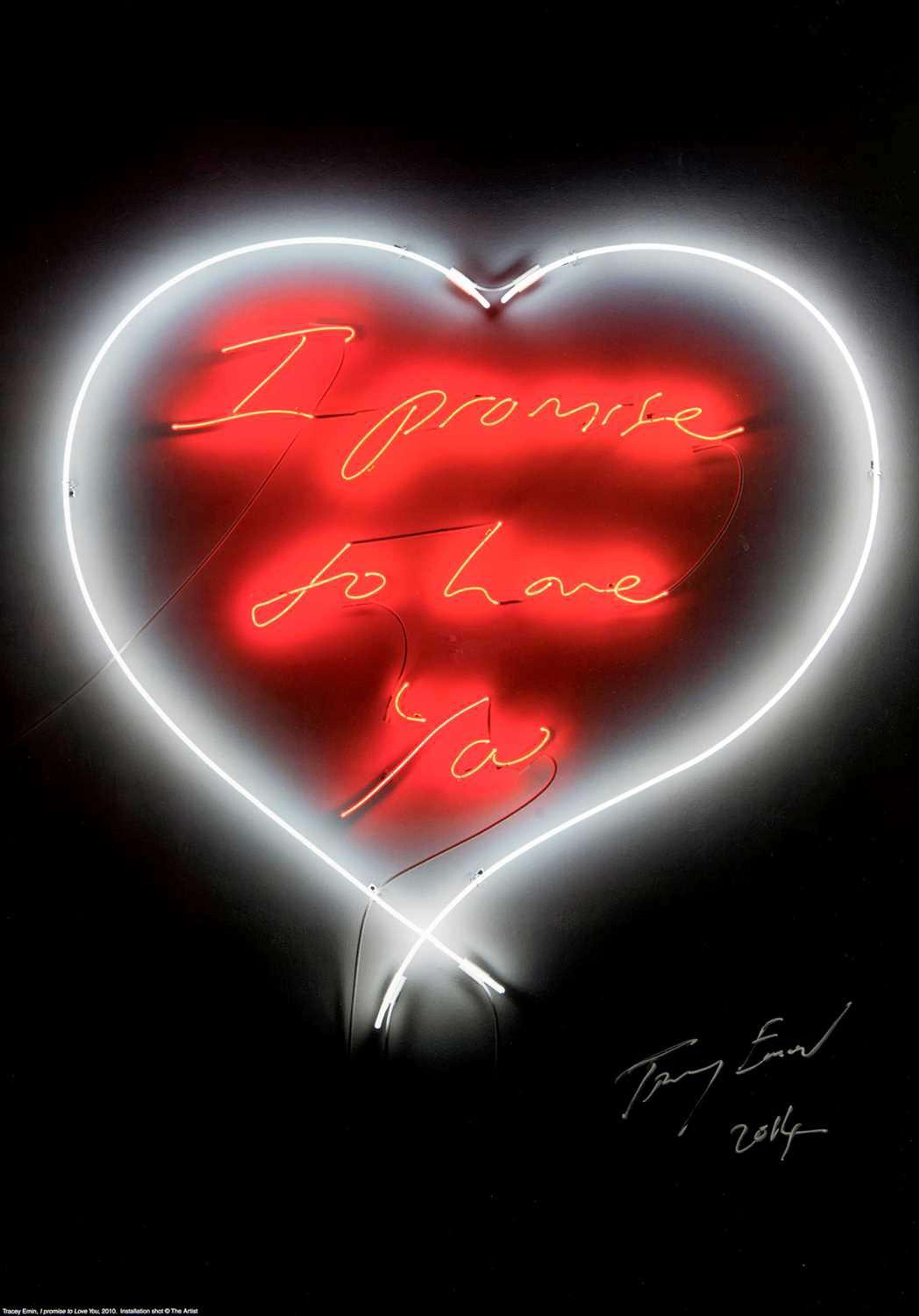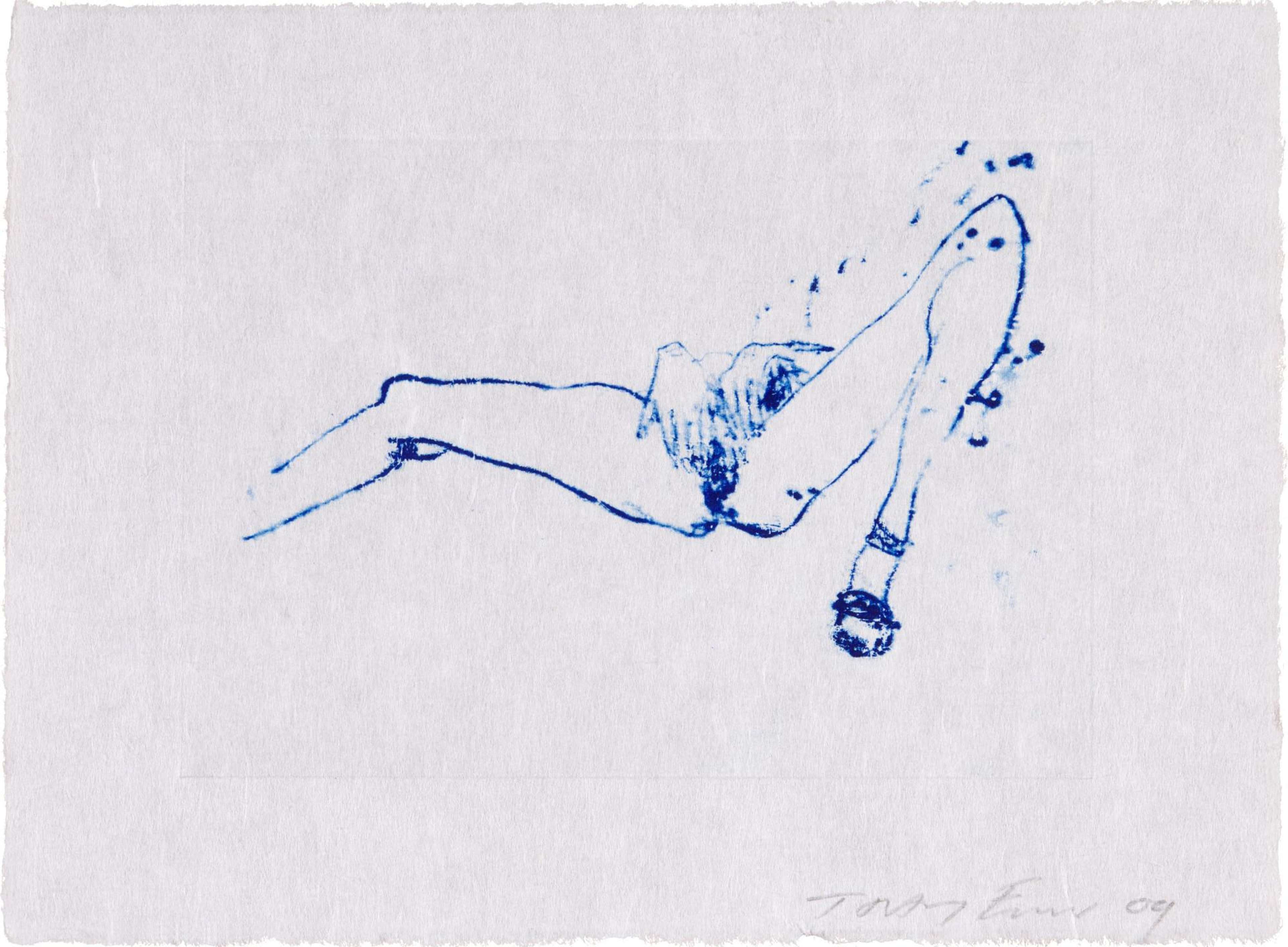Tracey Emin: Breaking Taboos

 On My Knees © Tracey Emin 2021
On My Knees © Tracey Emin 2021
Tracey Emin
142 works
Is there supposed to be something wrong with a woman who wants to display her darkest hours to the world? When My Bed was exhibited in 1999, Tracey Emin opened a door into what depression could look like. She bared it all, and instead of being met with praise for her bravery and emotive work, she was heavily criticised. Tracey’s love language is that of truth-telling, but how do you create art for a world that wants to filter it in the name of acceptability?
Who is Tracey Emin?
Tracey Emin, a prominent British artist praised for her provocative and deeply personal artworks, has made an undeniably significant impact on the contemporary art scene. With her unflinching exploration of sensitive subjects and the unapologetic exposure of her own vulnerabilities, she has continuously pushed the boundaries of artistic expression. Her fearless approach to addressing taboos has not only sparked controversy but has also opened up new avenues for artistic discourse and self-reflection. Examining the transformative power of her art, highlights the ways in which artists can challenge societal conventions, provoke dialogue, and inspire personal growth.
The Art of Tracey Emin
Born in London in 1963, Emin's tumultuous upbringing and personal experiences have had a profound impact on her artistic expression. Her art serves as a raw and introspective reflection of her life, eliminating the boundary between what should be kept private and what can go public.
My Bed garnered widespread attention and stirred intense debate. The installation featured her unmade bed, adorned with stained sheets, empty alcohol bottles, and discarded personal items. By displaying the intimate aftermath of her own mental breakdown, Emin battled societal expectations of decorum and privacy, confronting the messy realities of human existence.
Rivalling her bed was the tent embroidered with the names of all the people Emin had shared a bed with, including lovers, family members, and friends. By exposing her intimate relationships through Everyone I Have Ever Slept With in such a public manner, Tracey placed societal judgments surrounding promiscuity to the forefront and invited viewers to confront their own sexuality biases.
Emin's art often intertwines personal narratives with broader social issues. In one of her neon pieces, I Want My Time with You, she explores themes of love, longing, and vulnerability. The bright, illuminated text carries a profound emotional weight, displaying Tracey’s understanding of a universal longing for connection.
In her 2021 joint exhibition with Edvard Munch, The Loneliness Of The Soul, Tracey unveils a candid view of her tragedy and hope through a large selection of her works, many being shown for the first time.
Tacey Emin’s autobiographical art fosters an intimate dialogue among her audience. By visually embodying vulnerability, she ignites a transformative journey that encourages individuals to embrace authenticity and cultivate heightened self-awareness.
The Role of Sex and Erotica in Pushing Boundaries in Emin's Work
Sex and art have a long-standing connection, as seen through centuries of human expression. From ancient sculptures and Renaissance paintings to contemporary installations, the depiction of sexuality and eroticism has played a pivotal role in pushing artistic boundaries and challenging societal norms.
Renowned artists like Botticelli infused their works with subtle eroticism, often mixing mythological narratives with sensual imagery. Sandro Botticelli's The Birth Of Venus captivated viewers with its ethereal depiction of the goddess emerging from the sea, her nakedness symbolising beauty, purity, and desire–even though to the left of Venus, a woman is rushing to cover her. In this piece, we can see how some of the art during this time pushed the limits on what was considered acceptable while drawing viewers in with a seductive undertone.
In the modern era, artists continued to challenge societal norms through explicit and confrontational representations of sexuality. Gustav Courbet's scandalous painting L'Origine Du Monde shocked the art world with its graphic depiction of female genitalia, a direct affront to the prevailing prudishness of the time. It wasn’t until over the past few years the public has been able to determine the identity of the mystery model.
We see how Édouard Manet's Olympia defied conventions by portraying a naked reclining woman, boldly confronting viewers with an intentional and confrontational gaze that challenged traditional notions of femininity and sexual agency.
Tracey Emin's art boldly embraces this relationship, utilising sexuality and erotica as potent tools to challenge societal norms and push artistic boundaries. By investigating the intimate and often taboo realm of human sexuality in her work, Tracey explores the complexities and power dynamics inherent in our erotic experiences. Erotica, as a genre, has historically been stigmatised and relegated to the realm of the taboo. However, Emin fearlessly tackles this subject matter, reclaiming sexuality as a vital component of human experience. Through her art, she confronts the viewer with raw and unfiltered depictions of intimacy, exposing the complexities and nuances of sexual relationships.
The Debate on Social Disgust as Grounds for Restriction of Artistic Expression
Debates about what is acceptable in art isn’t a new concept. Social disgust can be defined as a feeling of aversion or repulsion triggered by art that deviates from societal norms. In art, this can justify the placing of restrictions on art. Advocates in support of social disgust hold the position that art has a profound impact on society and can potentially undermine social cohesion or promote harmful ideologies. Many believe that artworks considered socially disgusting may incite violence, perpetuate discrimination, or offend deeply held beliefs. For Tracey Emin and the king of controversial art, Damien Hirst, the character of their conceptual art came into question, especially with My Bed and The Physical Impossibility Of Death In The Mind Of Someone Living.
Opposing views suggests that art should not be restricted based on social disgust alone. Those in favour of artistic freedom argue that the subjective nature of social disgust makes it an unreliable criteria for determining artistic value or acceptability. They infer that restricting art solely on aversion stifles creativity, and limits innovation, both hallmarks for producing works that encourage dialogue and introspection. Artists have historically challenged societal norms, employing discomfort to support societal progress. Works that confront uncomfortable realities or taboo subjects can create new precedents for societal change.
Making Art Not Love: The Importance of Personal Expression
Personal expression lies at the heart of artistic creation, serving as a powerful vehicle for artists to convey their thoughts, emotions, and experiences. It is through this unfiltered lens that artists can forge intimate connections with their audience, delivering profound emotional responses and fostering a deeper understanding of the human condition. Tracey Emin, an artist celebrated for her raw and honest approach, epitomises the significance of personal expression in art, as she fearlessly draws from her own life to create thought-provoking and emotionally charged works.
Emin's art not only reflects her personal experiences and emotions but also resonates with audiences on a deeply personal level. Through her unfiltered expressions, she grants viewers permission to embrace their own complexities and challenges them to confront societal taboos head-on. By sharing her vulnerabilities, she creates a space for empathy, connection, and self-discovery. Emin's unwavering commitment to personal expression in her art has redefined the boundaries of artistic practice, inspiring countless artists to find their own authentic voice and encouraging viewers to engage with art as a transformative tool for self-reflection and understanding.
Does Art Have Boundaries?
Artists, driven by their creative instincts and the desire to communicate their perspectives, have consistently pushed the limits of artistic expression. By dismantling established boundaries, artists have initiated critical conversations and paved the way for groundbreaking artistic movements.
Surrealism, as an influential artistic movement, emerged as a direct result of breaking boundaries, especially when it came to representation and rationality. Salvador Dalí's provocative works pushed the boundaries of perception and reality, providing a transformative foundation for Surrealism to flourish. By turning away from visual reality and tapping into the depths of the subconscious mind, Dalí and other artists created a space for the exploration of the irrational, non-linear and imaginative aspects of human experience. Without artists like Dalí making a habit out of going against the grain and defying “normal” boundaries, we’d be without The Persistence of Memory, Un Chien Andalou, and an entire pivotal movement in art history.
Who decides what makes art, art anyway? The artist, the viewer, the collector?
Fast-forwarding to the contemporary art scene, Tracey Emin's art continues to test the boundaries of personal narrative and emotional exposure. By bravely exposing her personal struggles and experiences, Emin received a profound emotional response, continuing to prove the necessity for and benefits of creating beyond boundaries.
Bad Women Make Great Art
The bad girl of British art has long been a source of controversy and fascination. Critics and traditionalists have questioned the artistic merit of Tracey’s confessional pieces, dismissing them as attention-seeking. However, Emin's approach serves a higher purpose: to challenge the established art world and its expectations.
The controversy surrounding Emin stems not only from the explicit nature of her artwork but also from her unapologetic persona as a "bad woman" in the eyes of society. She refuses to conform to conventional expectations, openly discussing her personal struggles, relationships, and experiences with candid vulnerability. Emin's refusal to adhere to societal norms has earned her a reputation as a provocateur, a label she has embraced with defiance.
Tracey Emin on the Loose, 2008Emin's work has often been met with controversy and polarised opinions, with some critics accusing her of being self-indulgent or overly sensationalist. However, many others have praised her raw honesty, vulnerability, and courage in sharing her personal experiences and emotions through her art. In 1997, Emin appeared drunk during a live television interview about the Turner Prize, further fueling her reputation as the "bad girl" of British art. Drunk or not, Emin’s response was honest, and a testament to her unyielding authority over her work and her practice.
It is precisely this defiance, this rejection of societal norms and expectations, that fuels Emin's artistic practice. Her art becomes a tool for reclaiming her narrative and asserting her agency in a world that often attempts to silence and marginalise women. This may be best illustrated through My Bed. She tells on herself while showing people what society expects or demands women to be: poised, pure, polished–all of which are lost in her sheets.
Embracing Authenticity
Emin's art challenges societal conventions, provokes dialogue, and inspires personal growth through her fearless exploration of taboo subjects and her unapologetic self-expression. Emin's art not only challenges societal norms but also confronts the discomforts surrounding sexuality and erotica, reclaiming them as vital aspects of the human experience. Through the intimate encounter with her work, viewers are prompted to question their own lives, inspiring them to embark on a path of self-discovery and emotional growth.
Emin’s commitment to authenticity took on new depth through her battle with cancer, a journey that profoundly influenced her recent exhibition, I Followed You to the End. Her work is defined by visceral imagery, bold brushstrokes, and a palette brimming with emotional intensity, as she delves into the complexities of human relationships and the fragility of life. The exhibition reflects on the physical and emotional toll of survival, seamlessly blending autobiographical elements with mythological and symbolic themes. From her paintings to sculptures, Emin’s pieces radiate unfiltered honesty, compelling viewers to confront their own vulnerabilities and emotions.
Her storytelling and unfiltered expression prompts her audience to embrace their true power in vulnerability. By adhering to her vision, and fearlessly displaying her truth, Emin’s work embodies authenticity and offers instruction on how to embrace it. Viewers find something resonating about Tracey’s visual diaries, and it probably lies somewhere between the artist’s courage to tell the truth and their desire to face it.














